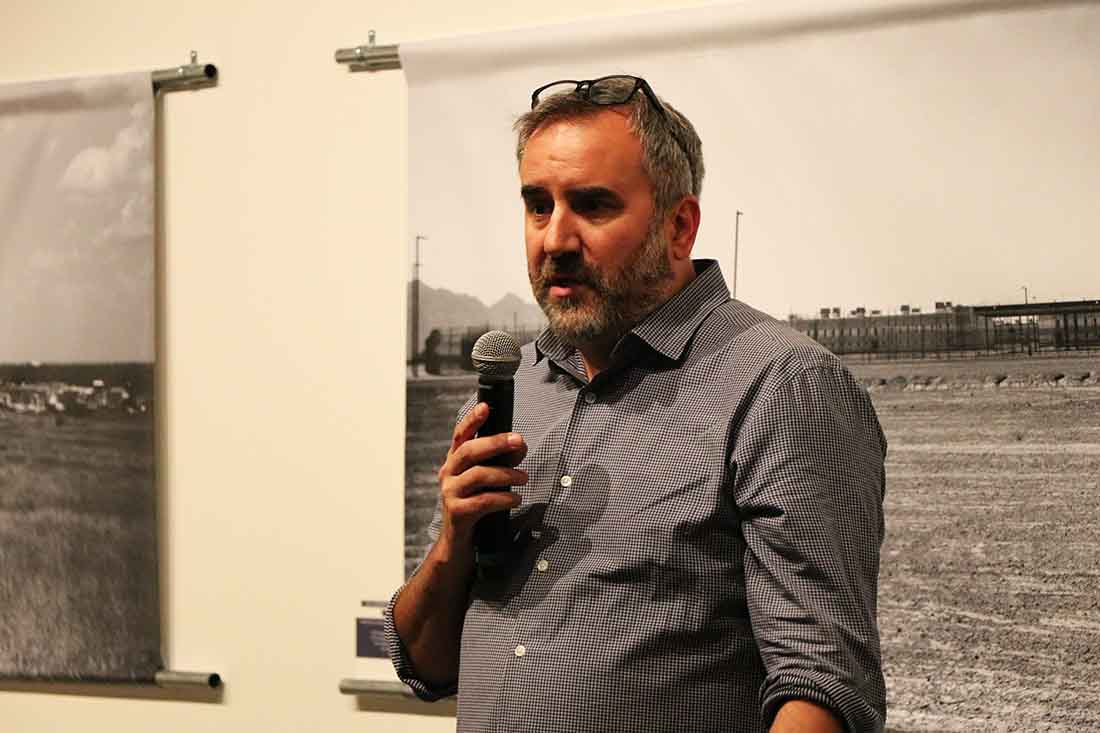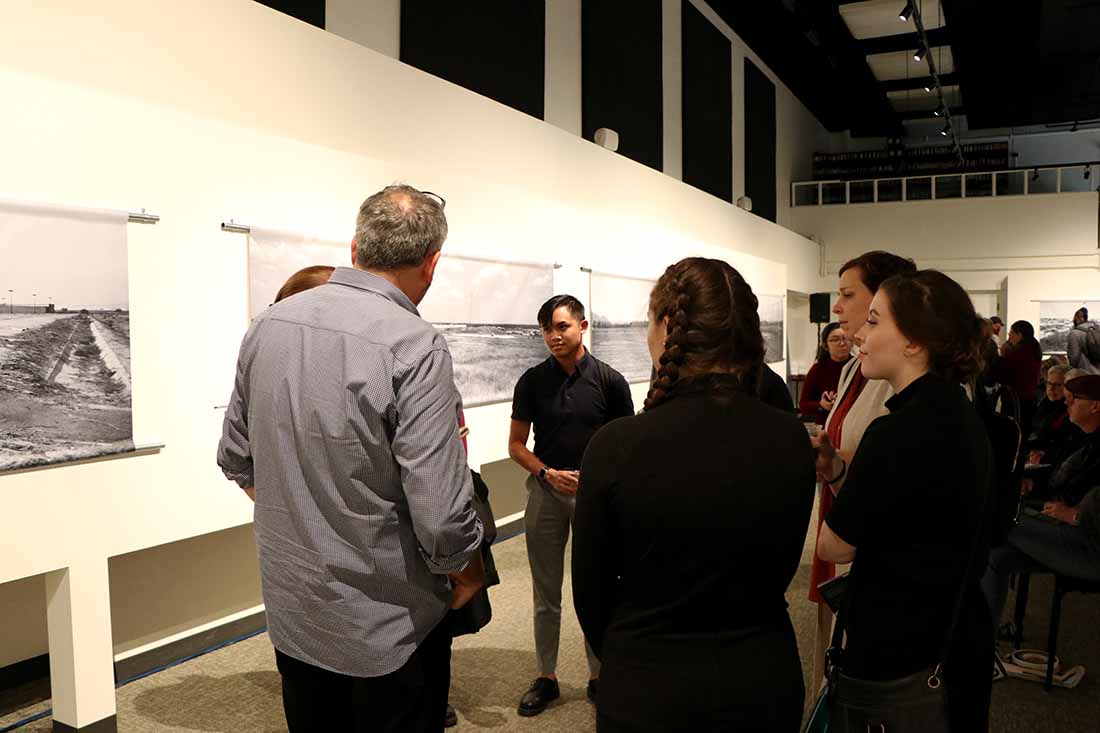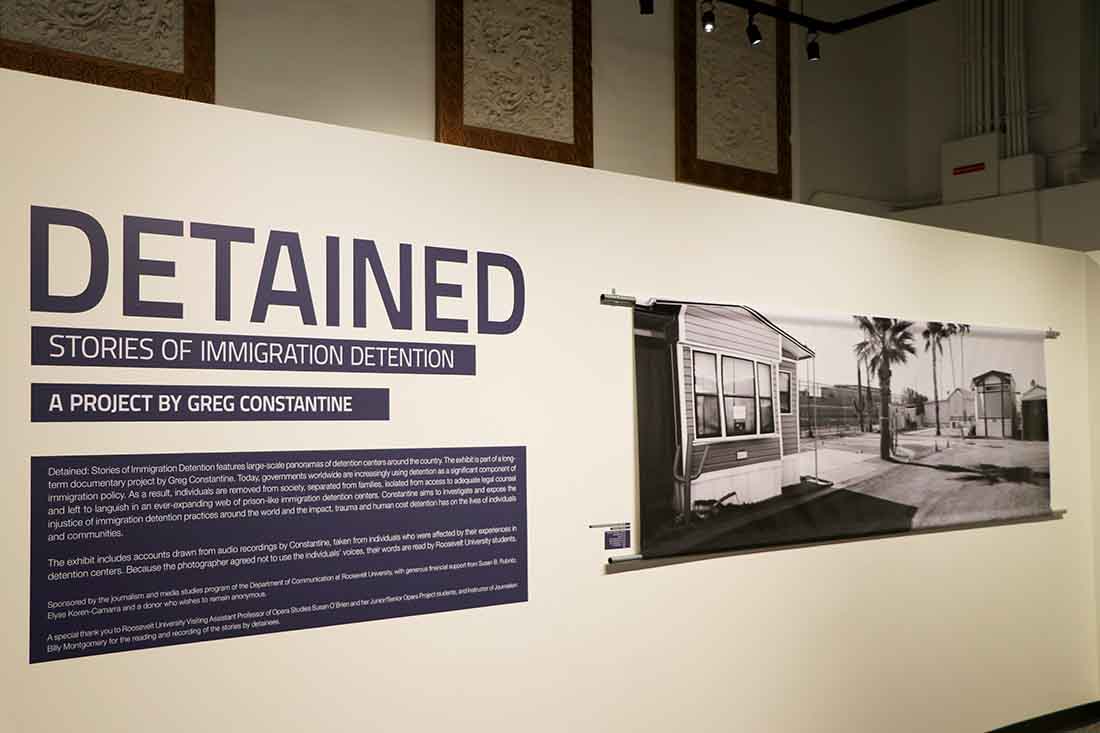By Carolina Gonzalez
Medill Reports
Barren land, industrial facilities, deserts and then a small concrete building in the middle of the void. These are the scenes portrayed in the 12 panoramic photographs covering the walls of the Gage Gallery in Chicago’s Loop.
Greg Constantine, a famed American social justice photographer, unveiled his latest work this month at the gallery at Roosevelt University. The series sheds a light on how ominous detention facilities really look from the outside, accompanied by stories from people who were caught inside.

Guests visiting “Detained: Stories of Immigration Detention” could hear recordings of immigrants’ stories playing in the space during an opening reception.
“Loss of freedom, constantly being monitored, being separated from family, friends and the outside world and not knowing if you will be released or being deported back to your country. That feeling is the story of my time in the United States prison.” These were some of the words playing in the background at the gallery, providing a testimony from those who had lived within these centers.
Then, Constantine shared his inspiration and goals for this project during a gallery talk.

“I think what interested me in getting involved in the project and the issue was that I felt that, even though it had been covered by media across the U.S., there were some pretty big significant visual gaps in how that story was being told,” Constantine explained. “I felt like I was in the position to be able to explore and investigate some of those gaps that the traditional media wouldn’t have the time to or would have to go to the next story and plus I think it’s a really important story.”
Constantine added that he felt most of the coverage on the immigration detention system had been through infographics or a map and he wanted to create some kind of visual photography to translate what the architecture of the buildings actually looks like.
“This is just only a small selection of 12 images that show where these places are, how ominous they are, how sinister they look.” Constantine said. “Also, it’s a reflection of just how isolated and desolate they are, and how isolated and desolate the people inside of must feel as well.”

Documenting the detention facilities and the stories behind them has been difficult and hard work.
“This part [of the project], I’ve spent two years working on it now and it has basically taken about six to eight months of networking my way in with different organizations and activists and lawyers and people who know people who have been in detention or released from detention,” Constantine said. “A lot of the times it’s impossible for me to get inside of a detention center which my camera which is totally fine with me. I’ve tried to be as calculating and responsible as I can in terms of where I’m taking photographs and but that’s still that has led to harassment, to sheriffs being called on me, police called on me by security personal of a lot of the facilities.”
Another setback in Constantine’s project has been that fact that no publication has wanted to print these images so far. Instead, he has printed out 20-24 page journals with his images and stories people told him about being in the detention centers. He has sent them to more than 700 outlets, lawyers, academic and activists groups, as well as given out at the exhibition, in order to create awareness.

“For me, it’s always about trying to see how far the work can go and how creative I can be in getting the work out there,” Constantine explained.
This exhibition draws on work from a six-part series called “7 Doors,” in which three of them are centered around immigration detention centers in the U.S. It is also one of the two exhibitions that are part of the Gage Gallery’s immigration theme.
Themes change yearly, Michael Ensdorf, director of the Gage Gallery said. “So, we’re going to have two exhibitions, very different exhibitions, addressing immigration and, you know, the impact the immigration policies have on the individual. It’s a timely topic,” especially with an election next year.
Ensdorf explained that showing social justice themes is a goal of the gallery, as well as educating people and giving space to hard-hitting documentary photography.

Constantine, who has similar goals for this work, previously published a book called Nowhere People, which documents stateless communities in countries in the Middle East, Southeast Asia, Europe, Africa and Latin America.
“(My goal) is to be able to provide a platform for people to become informed, to ask questions, to challenge stereotype stigmas, the preconceived notions of what we’re fed by the authorities and by the media itself,” Constantine said. “Also, I think in a way, you know, it’s to challenge people to expand their kind of understanding of what detention is and how it impacts people in the trauma that it inflicts on their own people.”
The exhibition is free and open to the public at the Gage Gallery, 425 S. Wabash Ave., through Dec. 12.
Editor’s note: A quote from Michael Ensdorf, director of the Gage Gallery, has been updated.


